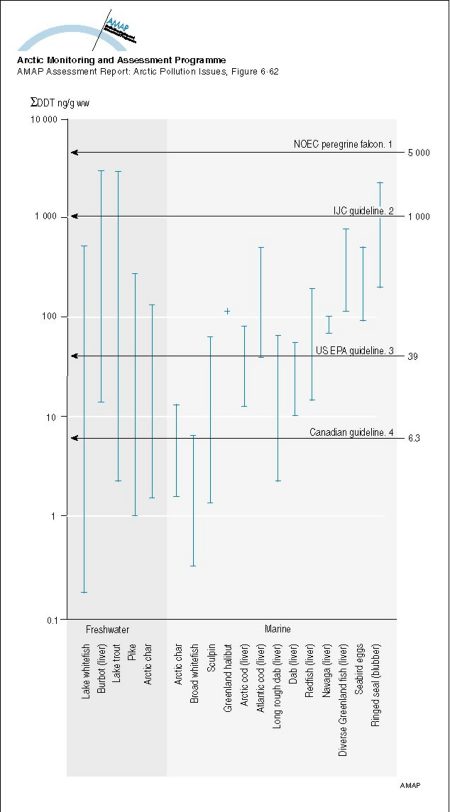More information and download links below the graphic.
Sum-DDT (ng/g ww) in Arctic animals as food items compared to no-effect-concentrations (NOAEC) and environmental quality guidelines for protecting fish-eating/aquatic wildlife (1 Baril et al 1990, 2 USEPA 1995,

Click here, or on the graphic, for full resolution.
Sum-DDT (ng/g ww) in Arctic animals as food items compared to no-effect-concentrations (NOAEC) and environmental quality guidelines for protecting fish-eating/aquatic wildlife (1 Baril et al 1990, 2 USEPA 1995,
| Sources | Baril, A., J.E. Elliott, J.D. Somers and G. Erickson, 1990. Residue levels of environmental contaminants in prey species of the Peregrine Falcon, Falco peregrinus, in Canada. Can. Field-Nat. 104: 273-284. USEPA, 1995. Great Lakes water quality initiative criteria documents for the protection of wildlife. U.S. Environmental Protection Agency, Office of Science and Technology, Washington D.C., EPA-820-B-95-008. DeVault, D., P. Bertram, D.M. Whittle and S. Rang, 1995. State of the Lakes Ecosystem Conference Background Paper, Toxic Contaminants. Environment Canada/US Environmental Protection Agency, Ottawa, EPA 905-R-95-016, 59p. Environment Canada, 1996. Draft environmental quality guidelines for PCBs, DDT, PCDD/Fs and cadmium. Unpublished data provided by R. Kent, Environment Canada, Environmental Conservation Service, Evaluation and Interpretation Branch, Ottawa. (AAR Figure 6.62) | ||||
|
Cartographer/ Designer |
Graphical production: Philippe Rekacewicz and Emmanuelle Bournay (GRID-Arendal) | ||||
| Appears in |
AMAP Assessment Report: Arctic Pollution Issues |
||||
| Published | 1998 | ||||
| Feedback/Comment/Inquiry | Contact webmaster | ||||
| Search for other graphics |
With related subjects Covering the same geographic area |
||||
|
Available Downloads
(please review use constraints above) |
|
||||
|
Citation/Reference Use constraints |
Please refer to the AMAP policy regarding use and reproduction of AMAP maps and graphics |
